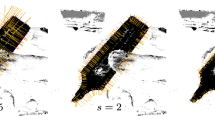Abstract
The problem of recovering the 3-D camera and scene structure has been intensively studied and is considered well understood. Starting with two images, a process of establishing point correspondences is usually followed by the estimation of epipolar geometry while also rejecting outlier matches, and finally by 3-D structure estimation. However, most existing methods tend to fail in the combined presence of noise and multiple motions, since no single constraint applies to the entire set of matches. Hence, image registration becomes a more challenging problem, as the matching and registration phases become interdependent. We propose a novel approach that decouples the above operations, allowing for separate handling of matching, outlier rejection, grouping and 3-D interpretation. Our method first determines an accurate representation in terms of dense velocities, segmented motion regions and boundaries, by enforcing only the smoothness of image motion, followed by the extraction of 3-D camera and scene geometry.
This research has been funded in part by the Integrated Media Systems Center, an NSF Engineering Research Center, Cooperative Agreement No. EEC-9529152, and by NSF Grant 9811883.
Preview
Unable to display preview. Download preview PDF.
Similar content being viewed by others
References
Longuet-Higgins, H.C.: A Computer Algorithm for Reconstructing a Scene from Two Projections. Nature 293, 133–135 (1981)
Adam, E.R., Shimshoni, L.: Ror: Rejection of Outliers by Rotations. Trans. PAMI 23(1), 78–84 (2001)
Zhang, Z.: Determining the Epipolar Geometry and Its Uncertainty: A Review. IJCV 27(2), 161–195 (1998)
Hartley, R.I.: In Defense of the 8-Point Algorithm. PAMI 19(6), 580–593 (1997)
Nicolescu, M., Medioni, G.: Layered 4D Representation and Voting for Grouping from Motion. Trans. PAMI – Special Issue on Perceptual Organization in Computer Vision 25(4), 492–501 (2003)
Ullman, S.: The Interpretation of Visual Motion. MIT Press, Cambridge (1979)
Huang, T., Netravali, A.: Motion and Structure from Feature Correspondences: A Review. P-IEEE 82, 252–268 (1994)
Hartley, R.: Projective Reconstruction and Invariants from Multiple Images. Trans. PAMI 16(10), 1036–1040 (1994)
Faugeras, O.: Stratification of 3-D Vision: Projective, Affine, and Metric Representations. J. Optical Society of America 12(3), 465–484 (1995)
Luong, Q.-T., Faugeras, O.: The Fundamental Matrix: Theory, Algorithms, and Stability Analysis. IJCV 17, 43–76 (1996)
Mohr, R., Veillon, F., Quan, L.: Relative 3D Reconstruction Using Multiple Uncalibrated Images. CVPR, 543–548 (1993)
Torr, P.H.S., Murray, D.W.: A Review of Robust Methods to Estimate the Fundamental Matrix. IJCV (1997)
Pritchett, P., Zisserman, A.: Wide Baseline Stereo Matching. In: ICCV, pp. 754–760 (1998)
Medioni, G., Lee, M.-S., Tang, C.-K.: A Computational Framework for Segmentation and Grouping. Elsevier Science, Amsterdam (2000)
Arya, S., Mount, D., Netanyahu, N., Silverman, R., Wu, A.: An Optimal Algorithm for Approximate Nearest Neighbor Searching in Fixed Dimensions. Journal of the ACM 45(6), 891–923 (1998)
Anandan, P.: A Computational Framework and an Algorithm for the Measurement of Visual Motion. IJCV 2, 283–310 (1989)
McReynolds, D., Lowe, D.: Rigidity Checking of 3D Point Correspondences Under Perspective Projection. Trans. PAMI 18(12), 1174–1185 (1996)
Scharstein, D., Szeliski, R.: High-Accuracy Stereo Depth Maps Using Structured Light. CVPR, 195–202 (2003)
Author information
Authors and Affiliations
Editor information
Editors and Affiliations
Rights and permissions
Copyright information
© 2006 Springer-Verlag Berlin Heidelberg
About this paper
Cite this paper
Nicolescu, M., Min, C., Medioni, G. (2006). Analysis and Interpretation of Multiple Motions Through Surface Saliency. In: MacLean, W.J. (eds) Spatial Coherence for Visual Motion Analysis. SCVMA 2004. Lecture Notes in Computer Science, vol 3667. Springer, Berlin, Heidelberg. https://doi.org/10.1007/11676959_10
Download citation
DOI: https://doi.org/10.1007/11676959_10
Publisher Name: Springer, Berlin, Heidelberg
Print ISBN: 978-3-540-32533-8
Online ISBN: 978-3-540-32534-5
eBook Packages: Computer ScienceComputer Science (R0)




